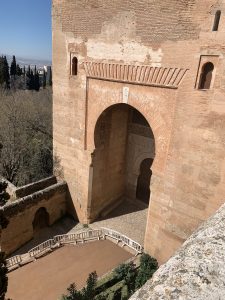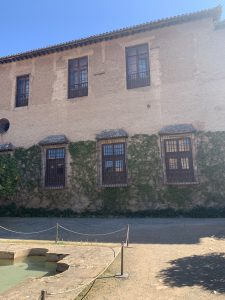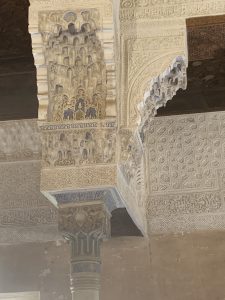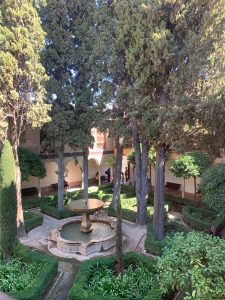By Sama Elmahdy
This class and trip has easily been the highlight of my Duke career so far. Being able to witness firsthand the complex relationships between the Christian, Jewish, and Muslim influences that we learned about was extremely enlightening. We were able to walk around the streets of Cordoba, Sevilla, and Granda, and point out the remnants of the Jewish and Muslim life that had once been so vibrant in Muslim-ruled Spain. We witnessed the beautiful Jewish quarters that are still present in many southern cities. We were able to experience the extravagance of the alcazars and the Alhambra. While, today many of the Muslim and Jewish artifacts are outshined by the Christian cathedrals and churches that abound, the intermingling for the three religions are undeniable.
Spain was first invaded by the Muslims in 711. Muslim rule would flourish and decline for over 700 years until 1492, when Granada was conquered. Granada was the last Andalusian city we visited during our trip. Granada is a beautiful city, and even presently, has a large Muslim community as well. The city also contains several cathedrals. One of the most notable being The Royal Cathedral, which houses the tombs of Queen Isabella I and King Ferdinand, the so-called Catholic Monarchs. The Cathedral is located right next to Albayzin, which is the prominent Arab quarter in Granada, and Alcaiceria, an area full of Arabic souks. While all these areas were vibrant, I found the Alhambra to be indescribably enchanting.

The Alhambra is an ancient palace and fortress created in the eighth century. It is the largest remnant from the Nasrid dynasty, the last Islamic kingdom in Western Europe. The Alhambra translates to “The Red,” named for the red walls and towers that surround it. The Alhambra consists of several palaces, seemingly never-ending gardens, and the civilian villages. All in all, the Alhambra spans nearly 26 acres.

I remember when we first spotted the Alhambra, we were on the main street and had to strain our necks to get the view of the enormous fortress located in the mountains. The beauty and power that emanated from it were enchanting. However, we also realized it would be painful as we treaded up the incline to the main entrance. We met our tour guide at the gate. Honestly, the Alhambra needs a tour guide; without one, it’s so easy to get lost in the grandeur that surrounds you. Our tour guide was able to explain the historical context of everything we saw, and made sure we didn’t overlook anything as we went through the tour.


Our tour started with a tour of the Muslim palaces that made up the fortified city. At first glance, the palaces didn’t look too impressive. From the outside, the buildings were bare, with minimal if any decorations. However, once inside the palaces, we saw the magnificence and splendor of Islamic art that overtook the walls and pillars of the rooms. Our tour guide later explained that according to Islamic tradition, one shouldn’t show off their wealth and beauty, and that it should be something saved for the inside.



We went from palace to palace, marveling at the carvings and the tile art that was prevalent in the architecture that surrounded us. I found the ceilings to be extremely gorgeous as well. Once upon a time, the ceilings also contained stain glass windows. However, our guide explained that all of windows were destroyed or removed, except for one. Most of the art had references to religion and served to praise God. The calligraphy that lined the walls centered around the central message of “la ghalib illa allah” which translates to “there is no victor/conqueror except God”.






We moved from the Muslim palaces to the Christian ones. As Granada was conquered by the Christians, King Charles V started the creation of some Christian palaces. This was an attempt to re-establish Christian dominance, and undermine the powerful Muslim leadership that had once existed. Once we toured all the palaces, we walked through to see the civilian city of Alhambra and the complex and gorgeous Generalife gardens that surrounded the fortress.





As the tour ended, our feet were undeniably sore, but the tour of Alhambra was well worth it. The abandoned city came to my life as I walked through it. As our tour guide painted a picture of the rulers residing within their palaces, overlooking the civilians living in the city below, I found myself transported to another time entirely. To me, the Alhambra was the most surreal experience on this trip. Despite the end of Muslim-ruled Spain, the Alhambra stands proudly as a beacon of the power and culture that the Muslims left behind.
